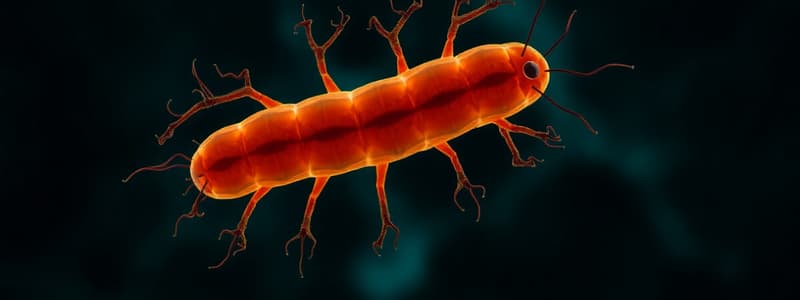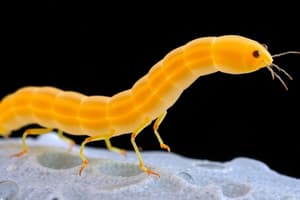Podcast
Questions and Answers
What is the primary function of PAR proteins during the early cell divisions of C.elegans?
What is the primary function of PAR proteins during the early cell divisions of C.elegans?
- To enable symmetrical cell division across all daughter cells
- To ensure complete inheritance of p-granules in all cells
- To facilitate differential localization between P and AB cells (correct)
- To initiate the fertilization process
During the first cell division of C.elegans, which proteins are primarily localized in the anterior cortex?
During the first cell division of C.elegans, which proteins are primarily localized in the anterior cortex?
- P-granules exclusively
- PAR-1 and PAR-2
- aPKC alone
- PAR-3 and PAR-6 (correct)
What effect does the organization of microtubules by the sperm centrosome have on PAR-2 during C.elegans cell division?
What effect does the organization of microtubules by the sperm centrosome have on PAR-2 during C.elegans cell division?
- It leads to the immediate destruction of PAR-2 in the cell
- It protects PAR-2 from phosphorylation, aiding its localization to the cortex (correct)
- It promotes its phosphorylation, preventing binding with PAR-1
- It restricts PAR-2 to the anterior cortex
Which of the following statements about the P1 and AB cells post-division is true?
Which of the following statements about the P1 and AB cells post-division is true?
What role do P-granules play in C.elegans embryonic development?
What role do P-granules play in C.elegans embryonic development?
What role does Numb play in the cell fate determination of sensory organ precursor cells in Drosophila?
What role does Numb play in the cell fate determination of sensory organ precursor cells in Drosophila?
How does overexpression of Numb affect sensory organ development in Drosophila?
How does overexpression of Numb affect sensory organ development in Drosophila?
What is the main function of the Par protein complex in neuroblast cell division?
What is the main function of the Par protein complex in neuroblast cell division?
What is the consequence of Numb promoting endocytosis of the Notch receptor in neural differentiation?
What is the consequence of Numb promoting endocytosis of the Notch receptor in neural differentiation?
During the early stages of neocortex formation in mammals, how do the early cortical neural stem cells divide?
During the early stages of neocortex formation in mammals, how do the early cortical neural stem cells divide?
What aspect of Numb's function is critical during asymmetric cell division in Drosophila neuroblasts?
What aspect of Numb's function is critical during asymmetric cell division in Drosophila neuroblasts?
Which of the following components is involved in directing spindle orientation through its binding to microtubules?
Which of the following components is involved in directing spindle orientation through its binding to microtubules?
What effect does the phosphorylation of Numb, Pros, and Brat by aPKC have after mitosis?
What effect does the phosphorylation of Numb, Pros, and Brat by aPKC have after mitosis?
What is the fate of the cell that inherits Numb during the asymmetric division of a neuroblast?
What is the fate of the cell that inherits Numb during the asymmetric division of a neuroblast?
What mechanism ensures that some daughter cells become neurons while others become part of the epidermis during neurogenesis?
What mechanism ensures that some daughter cells become neurons while others become part of the epidermis during neurogenesis?
Flashcards are hidden until you start studying
Study Notes
C.elegans Cell Division
- Par genes are involved in the asymmetric division of the nematode C.elegans.
- Par proteins regulate the distribution of cell fate determinants, influencing the development of different cell types.
- The P-granules are inherited by the posterior cell during the first four cell divisions.
- PAR-2 and PAR-1 localize to the posterior side.
- PAR-3, PAR-6, and PKC-3 localize to the anterior.
- PAR-3, PAR-6, and aPKC are displaced posteriorly by PAR-2 during the first cell division.
- PAR-2 is protected from phosphorylation by microtubules, allowing it to enter the cortex bound to PAR-1.
- The first cell division occurs around the time the egg pronucleus and sperm pronucleus fuse.
- The spindle rotates 90° to the anterior-posterior axis during the first division.
- The posterior nucleus is attracted to the cortical PAR-2/ PAR-1 which displaces the spindle to the posterior.
- The AB cell inherits PAR-3 and PAR-6.
- The P cell inherits PAR-3 and PAR-6 in the anterior cortex and PAR-1/ PAR-2 posteriorly.
- PIE-1 establishes the germline in P cells.
- Mex5/6 degrades PIE-1, which inhibits transcription factors.
- PAR-2 holds PAR-1, which inhibits Mex5/6.
- PAR-3/6 PKC-3 inhibits PAR-1.
Drosophila Sensory Organs
- Sensory organs in Drosophila develop from a sensory organ precursor (SOP) cell.
- Sensory organs are composed of four cell types, each derived from the SOP cell.
- Numb is essential for the asymmetric division of the SOP cell.
- Numb mutants lack most sensory organs.
- Numb is expressed in IIa cells, which differentiate into socket and hair cells.
- IIb cells differentiate into sheath cells and neurons.
- Numb is overexpressed in 'bald patch' flies, resulting in double neurons.
Drosophila Neurogenesis
- Drosophila neurogenesis involves the selection of neuroblasts from proneural clusters.
- Neuroblasts divide asymmetrically to produce a neuroblast and a ganglion mother cell (GMC).
- Insc is an adaptor protein that connects Baz/Par-3 to a complex containing Mud and microtubules.
- Mud binds to microtubules, directing spindle orientation.
- Pros is inherited by the GMC.
- Pros promotes neural differentiation and inhibits the cell cycle.
- Numb promotes endocytosis of the Notch receptor, inhibiting Notch signaling.
Mammalian Brain Development
- Early cortical neural stem cells (NSCs) divide symmetrically.
- NSCs divide asymmetrically later into NSCs and neuroblasts.
- Asymmetric divisions are characterized by the inheritance of Numb by the neuroblast.
- Neuroblasts migrate to the preplate layer, forming the beginnings of the neocortex.
- Later born neurons migrate past early neurons to form the cortical layers.
- NPCs later divide asymmetrically to produce glial cells.
Studying That Suits You
Use AI to generate personalized quizzes and flashcards to suit your learning preferences.




